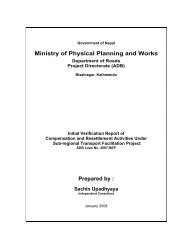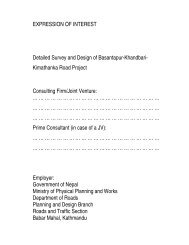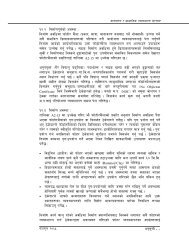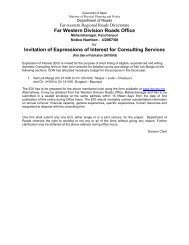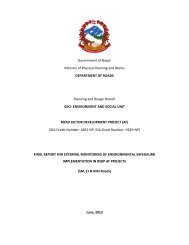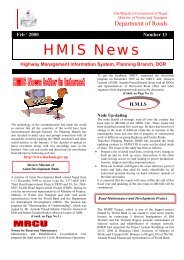Environmental & Social Management Framework - About ...
Environmental & Social Management Framework - About ...
Environmental & Social Management Framework - About ...
Create successful ePaper yourself
Turn your PDF publications into a flip-book with our unique Google optimized e-Paper software.
<strong>Environmental</strong> and <strong>Social</strong> <strong>Management</strong> <strong>Framework</strong>The Ministry of Physical Planning and Works (MoPPW) is the Concerned Agencyas per EPR, and is authorized to review and approve the IEE Report. TheMoPPW has the mandate to approval/rejection within 21 days of submission. Incase the IEE recommends further EIA study to be undertaken, the proponent hasto carry out the full scale EIA which comes under the jurisdiction of MoEST.Table 2.5:Table of Content of an IEE Report pertaining to SRN subprojectsChSub-Chapters Required in IEE Report1 1. Name and address of individual or institution preparing the report (proponent)2 2. Executive Summary, indicating- Proposal and detailed particulars of the area where the project is implemented- Objectives of proposal- Impacts on Land-use- Adverse impacts on environment, impacts on human life, population pressure- Damage to be suffered by local goods or objects- Other necessary matters3 3. Technical Information3.1 Type of proposal and Project Description (nature, location)3.2 Technology and materials to be used3.3 Emissions resulting from the implementation of the proposal3.4 Energy to be used3.5 Manpower requirements3.6 Resources required for the implementation of the proposals3.7 Other necessary matters4 4. Impacts of implementation of the proposal on the environment:4.1 Physical impacts4.2 Biological impacts4.3 Impacts on social, economic, and cultural domain5 5. Alternatives for implementation of the proposal6 6. Measures to reduce or control the impact of implementation of the proposal on theenvironment7 7. Matters to be monitored while implementing the proposal8 8. Other necessary matters9 9. (or Annex): Data, maps, photographs, tables, charts, graphs, etc. as required[Ref.: in accord with EPR 1997, Schedule 5]To summarize, an IEE is essentially a miniform of EIA which involves impactidentification, mitigation measures, monitoring and public involvement. However,as the impacts and mitigation measures of the project implementation aregenerally identified as moderate and/or manageable, detailed investigation, asrequired in EIA, is not required to be undertaken in IEE. Information is mainlyretrieved from secondary sources, with limited efforts in field studies. Householdlevel survey is not necessary and Focus Group Discussions are generallysufficient for collecting primary information. In most cases where road upgradingis the main activity of a proposed project, an IEE is sufficient enough to provide adefinite solution to cope with anticipated environmental problems, and even todescribe all necessary arrangements for dislocation of people should this be anessential requirement for, e.g. widening a road to the desired formation width.Under the condition that this will affect only a very limited number of houses andpeople (up to 100, as specified threshold in the EPF, 1977)) an EIA is generallynot required and an IEE will suffice. Regardless of whether an IEE or EIA iscarried out, each will result in a detailed, site-specific <strong>Environmental</strong> <strong>Management</strong>Action Plan (EMAP) that forms the basis for supervision and monitoring (both theeffects and the compliance monitoring).The scoping exercise must be based on a rapid site reconnaissance surveyconducted by professional EA practitioners.Chapter 2-10 April 2007



![j:6 ]zg cfof ]hgf](https://img.yumpu.com/51286794/1/190x245/j6-zg-cfof-hgf.jpg?quality=85)

![x'nfsL /fhdfu { cfof ]hgf](https://img.yumpu.com/50581959/1/190x245/xnfsl-fhdfu-cfof-hgf.jpg?quality=85)
